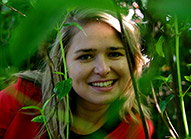Joanna Skubisz
PhD student and researcher
I'm a PhD grant holder in the ERC-funded "BlackBox: Arts & Cognition" project (Multimodal Communication / Linguistic section), where I study the verbal and non-verbal behavior of people from Performing Arts domain. In particular, I investigate the form and function of non-lexical vocalizations and tactile communication in choreographer-dancer collaborative work and study how these phenomena modulate social interaction. My research interests are Gesture Studies, Multimodal Communication, Cognitive Sciences, and quantitative methodologies.
I received my Master of Arts degree in German Philology and German as a Foreign Language at Bielefeld University (2014), writing a thesis about the communicative functions of listeners’ non-verbal behaviour, focusing head-gesture movements. In brief, I was questioning if and how communicative feedback functions can be assigned to head-gestures, independently from speech.
As a research assistant (2011-2014) in the "Rhythm and timing in dialogue project" (PI: Prof. Petra Wagner), I collected, annotated (using ELAN and PRAAT), analyzed, pre- and post-processed large speech and gesture data, as well as gained insights into the maintenance process and ethical issues of multimodal corpora.
I have six years of teaching experience to graduate and undergraduate students from Bielefeld University, where I taught "Introduction to German linguistics" (2008-2010) and "Introduction to language teaching" (2010-2013). Teaching was a natural outcome of my previous qualifications from PWSZ Konin (Poland), where I studied methodology and didactics of German language and received my Bachelor's degree (2009).
Within BlackBox project, I am investigating language (speech and gestures) and language like phenomena (non-lexical vocalizations and touch), and study how they shape the social context of performers being engaged in creative activities. In my PhD thesis, I am researching the iconic relationship between choreographer’s non-lexical vocalizations (i.e. their prosodic and acoustic features) and dancer’s body movements.
Publications:
1. Evola, V. & Skubisz, J. (2019). "Coordinated Collaboration and Nonverbal Social Interactions: A Formal and Functional Analysis of Gaze, Gestures, and Other Body Movements in a Contemporary Dance Improvisation Performance". Journal of Nonverbal Behavior (in press, December 2019). DOI: http://doi.org/10.1007/s10919-019-00313-2 Available in open access (online first) at: https://link.springer.com/article/10.1007%2Fs10919-019-00313-2
2. Evola, V., Skubisz, J., & Fernandes, C. (2019). Data and Material for “Coordinated collaboration and nonverbal social interactions.” https://doi.org/10.17605/OSF.
3. Fernandes, C., Evola, V., & Skubisz, J. (2019). Performance mode under the microscope: a cognitive semiotic analysis of eye gaze and other body movements in a contemporary dance improvisation. In Galhano-Rodrigues, I., Zagar Galvão, E., and Cruz-Santos, A. (Eds.). Recent Perspectives on Gesture and Multimodality. Newcastle upon Tyne: Cambridge Scholars Publishing. pp. 121-135
4. Evola, V., Skubisz, J. and Fernandes C. (2016). The Role of Eye Gaze and Body Movements in Turn-Taking during a Contemporary Dance Improvisation. In: Gilmartin, E., Cerrato, L., Campbell, N. (eds). Proceedings from the 3rd European Symposium on Multimodal Communication, Dublin, September 17-18, 2015. Linköping: LiU Press. pp.24-31. Full Paper
5. Malisz, Z., Włodarczak, M., Buschmeier, H., Skubisz, J., Kopp, S., & Wagner, P.(2016). The ALICO corpus: analysing the active listener. Language resources and evaluation, 50(2), 411-442. Full Paper

Email: joanna.skubisz@fcsh.unl.pt



